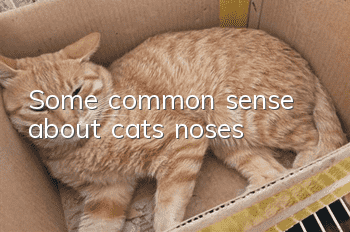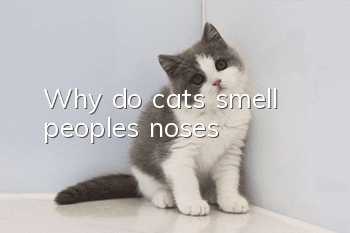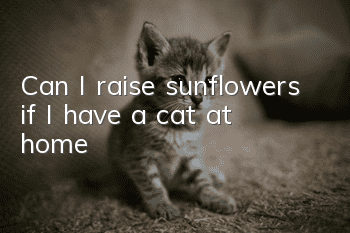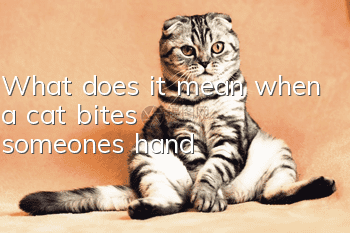Some common sense about cats’ noses

The nose is one of the very important organs of cats. This article will teach you some common sense about cats’ noses.
01
Cats’ noses are very sensitive. When at close range, cats use their sense of smell instead of vision.
A one-day-old kitten can use its sense of smell to navigate to the mother cat’s nipples.
Anatomically speaking, the key to mammalian olfactory sensitivity is comparing the area of their olfactory epithelium, which is densely populated with odor receptors.
As for this data, humans are 2-4 square centimeters, cats are 20 square centimeters, and dogs can reach up to 170 square centimeters.
The number of receivers is 5 million for humans, 200 million for cats, and 220 million for dogs.
Although cats and dogs have about the same number of receptors, because the dog's olfactory epithelium is much larger than that of the cat, the dog's sense of smell is more sensitive than that of the cat.
Most data give a range that cats’ sense of smell is 13-20 times that of humans, while dogs’ sense of smell is 50-100 times that of humans.
02
From the appearance, the structure of a cat’s nose is not complicated at all. It consists of three parts: philtrum, nose, and nostrils.
The nose is a very interesting structure. If you observe carefully, you will find a lot of small round protruding nodules on it. The composition of these nodules makes the nose of each cat different.
The nose is equivalent to a person’s fingerprint, and everyone is different.
The philtrum can also be said to be a very important acupoint. In my "Core Secrets of Purebred Cat Breeding", I have a course specifically on how to use this acupoint to save newborns who are dying.
There is nothing to say about the nostrils. For a normal cat, the nostrils on both sides should be symmetrical.
We will not delve into the internal structure of the nasal cavity. For ordinary cat lovers, it is of little significance to delve into it.
The cat’s sense of smell has a very important accessory structure, which must be mentioned here.
That is the cat’s vomeronasal organ, also called Jacob’s organ.
This organ is located in the cat’s mouth. There are two small fluid-filled sacs on the roof of the mouth. This is it.
Through two tubes, the vomeronasal organ connects the nasal cavity and oral cavity. The most important role of the vomeronasal organ is to participate in the cat’s cleft lip sniffing response.
When you see your cat, open your mouth slightly, then make an action that seems to be making a face, and then remain still with the nose slightly tightened. This is the cleft sniffing behavior that is taking place.
This behavior occurs most often in male cats, especially those in the wild.
When they are looking for a mate, they will take a deep breath wherever they find the scent left by the female cat.
Through the cleft lip sniffing reaction, the male cat can determine a lot of information about the female cat, such as whether she is healthy, how old she is, etc.
Of course, there are many more intentions for this behavior, which is not to say that it is only found in male cats. You can also see this behavior in two-month-old kittens.
The above is about the structure of a cat’s nose.
03
I have talked about the functions of different parts sporadically. Let’s talk about the main functions of the cat’s nose as a whole:
1. Self-navigation
2. Identify different creatures (including other cats, dogs, and us humans, etc.)
3. Identify threatening odors
4. Arouse appetite
Cats can get a lot of information through smell, and the way two cats say hello is also through smell.
Generally speaking, cats will avoid interacting with cats in other "territories" to some extent.
But if they can communicate, the first step must be nose to nose, beard to beard. This is the first way they receive information from each other.
After each other puts down their hostility, if they want to go further, it usually involves smelling each other's butts.
Because there are dense glands around the buttocks, and the glandular secretions contain more information about the cat.
Generally speaking, a cat with an average sense of self will not let a cat smell its butt to a cat it thinks is more powerful than itself. But if you give it to the other party, it means that you trust each other.
Two familiar, peaceful and friendly cats usually smell each other's butts as a sign of long live friendship.
So, if you have a cat who is willing to point its butt at you, it means that it has full trust in you. Don’t feel overwhelmed or disgusted. Give it feedback with your love!
Since cats’ sense of taste is not that developed, their nose plays a very important role in eating.
Before a cat eats, he must smell it first. He will not be like some silly dogs who feel something is wrong after eating poop.
So the nose arouses appetite very muchAn important organ, so if a cat suffers from upper respiratory tract problems for a long time, its appetite will also be problematic.
Similarly, unscrupulous cat food merchants who are familiar with this feature will also use their brains to think of various ways to make the smell of cat food or canned food more attractive.
They may spend a lot of money to develop food attractants and ignore the ingredients of cat food itself, because for some parents who don’t understand, this food may be good if it is more palatable.
Therefore, you must remember that just because cat food is palatable, it does not mean that food is good.
So following this clue, if the cat’s nose is not breathable, how can we increase its appetite?
Yes, just find ways to increase the smell of food. There are many ways to do this.
For example, heat the canned food slightly (make sure it is not hot after heating).
For example, add gravy from cans to cat food.
For example, give your cat some pureed meat that babies eat. Baby meat puree usually has a strong smell.
- The cat keeps meowing with its tail raised
- Things to note during cat training. Even an unruly cat can be obedient!
- What should I do if my cat likes to scratch the sofa? How to change my cat’s habit of scratching the sofa?
- Why don’t cats like to have their nails cut?
- What should newbies pay attention to when raising cats?
- Can cats eat dragon fruit?
- What does it mean when Chinchilla’s tail is oily? Be alert that this disease is coming quietly!
- What are the symptoms of a happy kitten?
- How old is a British shorthair cat?
- Is it normal for a cat to move a kitten in its mouth?



